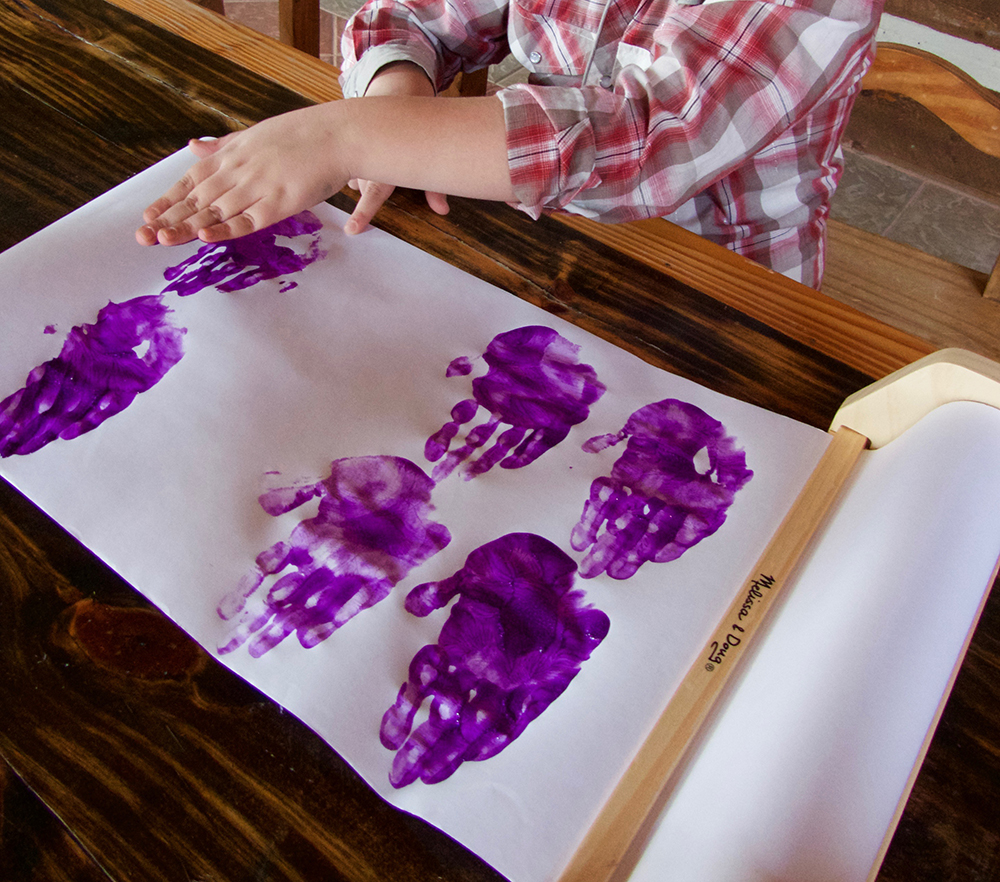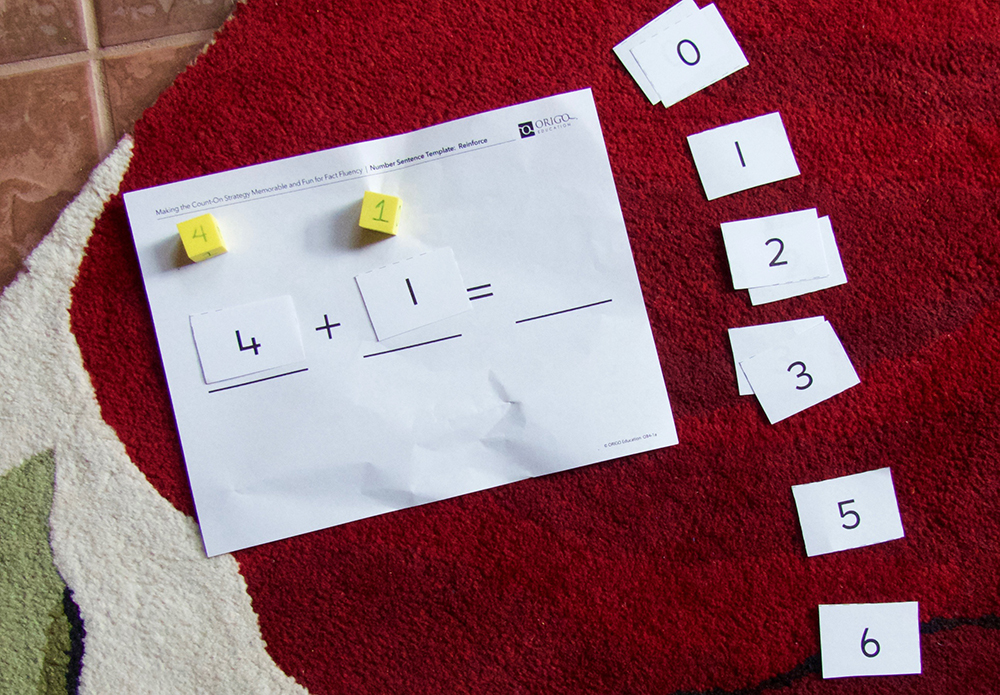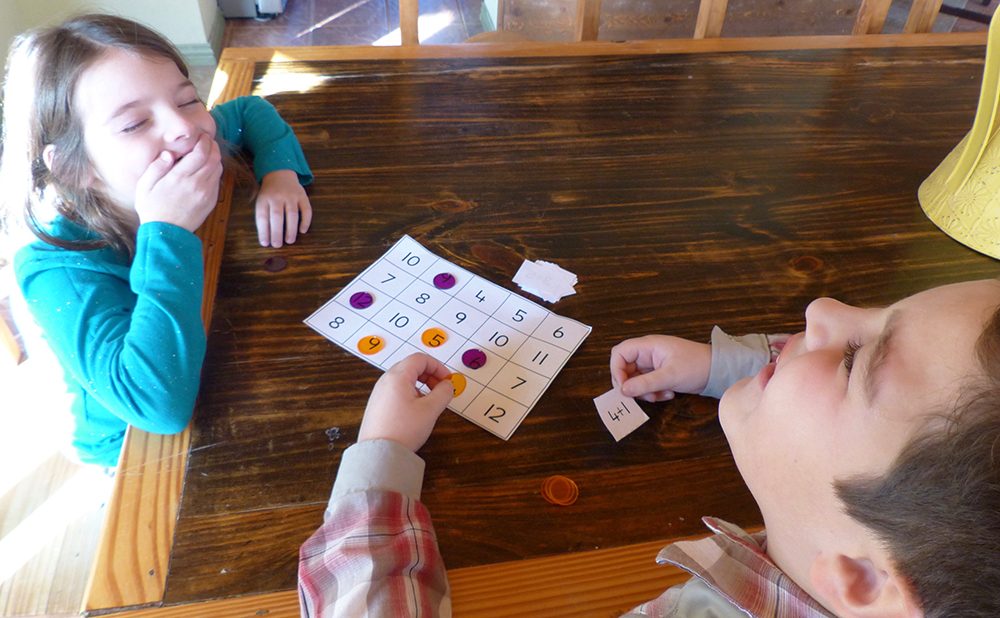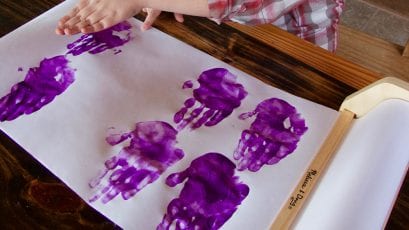Addition and Subtraction
Making the Count-On Strategy Memorable and Fun for Fact Fluency
The count-on strategy for addition will help children master sixty-four math facts!
Yes, sixty-four! But first, what is the count-on strategy? Watch this ORIGO One video below to learn more!
Teaching the count-on strategy for addition from ORIGO Education on Vimeo.
Count On Facts Addition Fluency: Count On Strategy Games and Activities
When I work with children, I get the best results when we link the learning to a memorable, fun experience. Below are some great activities to support fact fluency with the count-on strategy.
Introduce the Count On Strategy
To introduce the count-on strategy, first ensure children have experienced the math in a “hands-on” way. The key to success with this concrete experience is to make sure children “count on” rather than “count all.”
What you need: Washable paint; large construction paper; cube labeled 0, 1, 1, 2, 2, 3
What you do: Fold each paper in half. Invite the children to create a page for each of the numbers 1-6, by placing that many painted handprints on the left side of the paper. Give the papers time to dry.
What the children do: Invite one child to roll the cube. Then, encourage the child to say the number of handprints on the sheet of paper and count on the number rolled as they paint that many new handprints on the right side of the paper.

In this picture, you will see a child adding two handprints to their paper. The child “counts on” out loud as he engages in the activity. I have four and will add two. I have four, (paint) five, (paint) six. There are now six handprints.
Strategy Tip: Once the children’s papers dry, you can use the papers to practice turnaround facts! Holding the paper one way, you might read it as, “4 and 2 make six”. Turn the same paper around to read it as, “2 and 4 make six”. This is a great way to learn two facts with one paper!
Reinforce the Strategy
Once children have done many concrete and pictorial activities to understand the count-on strategy, you can move to the Reinforce stage of the learning progression. In the Reinforce stage, children start to link their concrete and pictorial understanding to an abstract and symbolic representation.
What you need: 1 cube labeled 0, 1, 1, 2, 2, 3; 1 cube labeled 1, 2, 3, 4, 5, 6; number sentence template
What you do: Cut out the numerals from the printed template.
What the children do: Roll the cubes and read the number sentence out loud. Then, select the numerals to match the quantities rolled and place on the number sentence template. Last, invite the child to do an action to show their count-on understanding.

In this picture, a child is rolling the cubes and placing the numerals on the number sentence template. Next, the child will count on the number with jumping jacks. I rolled four and one. I have four and (jumping jack) five. 4 add 1 is 5.
Strategy Tip: Be sure to ask the child to describe how they solved the problem. Encourage them to use turnaround understanding to help scaffold their thoughts as necessary.
Practice the Strategy
Once children have made the connections between concrete, pictorial, and symbolic representations with the count-on facts, it is time to practice fluency and recall.
What you need: Fundamentals Count-On Game Board (download yours from our Resource Hub) counters
What you do: Cut out the number fact cards and place in a pile face down next to the game board.
What the children do: Play the Count-On Game in groups of two or three. Each child will flip a card over and place their color counter on the answer. Children take turns until all spaces are filled. If there are no more answers on the board for a selected card, the player loses their turn. The winner is the player who has the most counters on the game board.

Strategy Tip: Encourage children to solve the answer aloud for their group. This helps the child verbalize their math understanding, and other children in the group hear different ways to solve the problem.
Extend the Strategy
Encourage children to apply this strategy to numbers beyond the basic facts. For example, the strategy can be extended to solve 26+2. This is specifically highlighted in the “What is the count on strategy” ORIGO One video referenced above!
The count-on strategy for addition is one of many important strategies included in The Box and Book of Facts for Addition and Subtraction from ORIGO Education. Use these strategies to grow count on facts fluency and mental computation power of YOUR students!
Click here to download the count on strategy facts game.
Learn more in our series with the first post about Number Facts. Then check out our Division Facts post for more information.
About ORIGO Education
ORIGO Education is dedicated to making learning meaningful, enjoyable and accessible for all students with Pre-K and Elementary print and digital instructional materials, as well as professional learning for mathematics.
![]()




